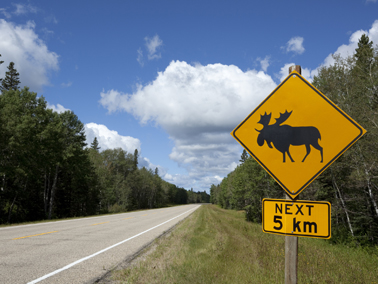Reduce the risks
Wild animals can be unpredictable. An animal grazing in the ditch can jump in front of your car without warning. Here’s how to reduce the risks:
- Keep your seatbelt buckled.
- Don’t drive distracted. Make sure you are alert and sober.
- Keep your windshield and headlights clean.
- If you’re driving at night, use high beams when there’s no oncoming traffic.
- Try to avoid driving at dawn and dusk when wild animals are most active and sun glare can reduce visibility.
Be prepared
How would you react if a wild animal suddenly darted out in front of you? Here are some driving tips to help you know what to do if you see an animal on the road.
Slow down
Take extra care on clear nights. Some studies show that animal collisions are more common in good weather on long straight stretches of road. This may be because drivers drive faster than they would in poor conditions.
Drive defensively
Take extra care in areas with reduced visibility – on hills, bends or where vegetation is dense.
Watch for wildlife warning signs
Those yellow diamond-shaped signs are there for a reason. They’re posted in areas with a lot of wildlife or where animal crossings are common.
Scan the road
Look out for movement on and alongside the road. Remember if you see one animal, there may be others nearby. (Think doe/fawn or moose cow/calf pairs.)
If you see a wild animal
- Slow down. You’ll have more time to react at slower speeds.
- Use your horn or flash your lights to help warn the animal away.
- Grip the steering wheel and stay on the road. Stay in control.
- If you have time, warn vehicles behind you by pumping your breaks or turning on your hazard lights.
Avoid a collision if you can
Smaller animals
If there are no cars around, slow down and drive carefully around the animal. If there are other cars around, brake hard in a straight line. Avoid swerving out of your lane because you could hit another vehicle.
Larger animals, like deer or moose
Do what you can to avoid hitting the animal. Moose can weigh up to 500 kg, so you could get seriously injured if you hit one. As a last resort, you may need to swerve out of the way.
If you can’t avoid the animal
If you can’t avoid a collision, aim to keep yourself, your passengers and other drivers safe.
Drive towards the spot the animal is coming from, not where it is going. Brake firmly and quickly, then steer your vehicle to strike the animal at an angle. Let up on the brake just before you hit the animal. This reduces the chances of the animal coming through your windshield.
If you hit an animal
- Pull off the road wherever it’s safe to do so.
- Turn on your hazard lights.
- If the animal is lying in the road, direct your headlights towards it so other drivers can see it.
- Don’t approach the animal—an injured animal can be very dangerous.
Who to contact after an accident
It’s important to report collisions with larger animals so highway managers can identify areas where wildlife collisions are frequent and take steps to reduce the risks in those areas. If you’re driving in another province, reporting requirements may be different.
- If your vehicle is damaged or if anyone is injured, call 911 or the RCMP and contact your insurance company for help and to make a claim.
- If you’re driving in Quebec, you must report a collision with certain animals to a wildlife protection officer.
- If you’re driving in Ontario and you hit a deer or a moose, you must report the accident to the local police or the Ministry of Natural Resources.
- If you’re driving in British Columbia, contact the Conservation Officer Service.
- If you’re driving in a national park, contact the park wardens. Reporting the exact location helps wardens monitor injured animals and recover dead ones. Quick removal prevents other animals from being attracted to the highway.
For more on this topic, visit:
What should you do if you see an animal on the road
Wildlife Collision Prevention Program: Hints for the highway

